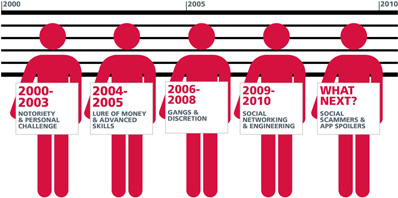A good decade for cybercrime
For Internet users, it has been a decade of exciting online advances that allow people to communicate, share information and conduct business in ways that were never before possible. However, cybercrime has also flourished over the last decade, growing by double digits year after year, and costing consumers hundreds of millions of dollars every year.

The latest report from McAfee, “A Good Decade for Cybercrime,” examines the past ten years of cybercriminal tactics and online threats, an era that dramatically changed the face of crime.
Top exploits representing different eras of cybercrime:
1. “I LOVE YOU” worm’s false affection: Estimated damage $15 billion
The “I love you” worm (named after the subject line of the email it came in) proved irresistible in 2000 as millions of users opened the spam message and downloaded the attached “love letter” file and a bitter virus. This infamous worm cost companies and government agencies $15 billion to shut down their computers and remove the infection.
2. MyDoom’s mass infection: Estimated damage $38 billion
This fast-moving worm first struck in 2004 and tops McAfee’s list in terms of monetary damage. Due to all the spam it sent, it slowed down global Internet access by 10% and reduced access to some websites by 50%, causing billions in dollars of lost productivity and online sales.
3. Conficker’s stealthy destruction: Estimated damage $9.1 billion
This 2007 worm infected millions of computers and then took its infections further than the last two worms on our list, as cybercrooks moved from notoriety to professionalism. Conficker was designed to download and install malware from sites controlled by the virus writers.
Top scams:
1. Fake anti-virus software – Selling fake antivirus software is one of the most insidious and successful scams of recent years. Cybercrooks play on users’ fear that their computer and information is at-risk by displaying misleading pop-ups that prompt the victim to “purchase” antivirus software to fix the problem. When the victim agrees to purchase, their credit card information is stolen and they wind up downloading malware instead of security software.
2. Phishing xcams – Phishing, or trying to trick users into giving up personal information, is one of the most common and persistent online threats. Phishing can come in spam emails, spam instant messages, fake friend requests or social networking posts.
3. Phony websites – In recent years, cybercrooks have become adept at creating fake websites that look like the real deal. From phony banking sites, to auction sites and e-commerce pages, crooks are constantly laying online traps hoping you will be fooled into entering your credit card or personal information.
Looking ahead to future cybercrime trends, McAfee Labs predicts the continuation of social networking scams and tricks, such as malicious links, phony friend requests and phishing attempts. The scams are likely to get more sophisticated and personalized, especially if users continue to share a great deal of information.
The complete PDF report is available here.